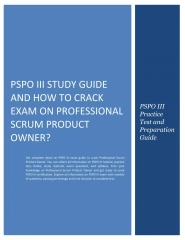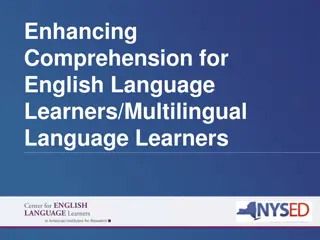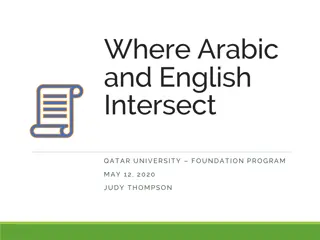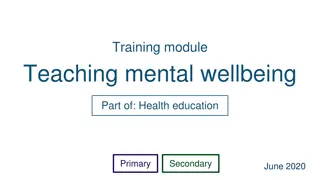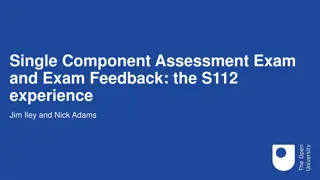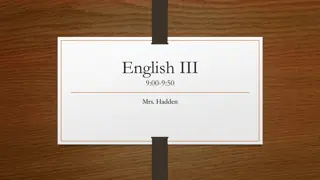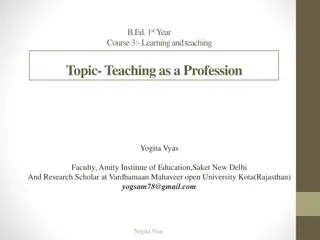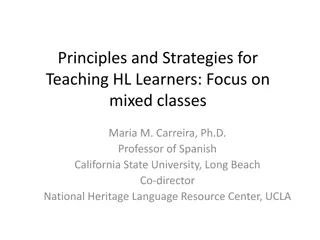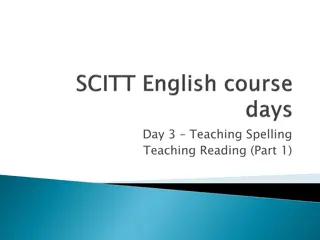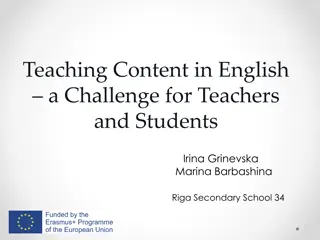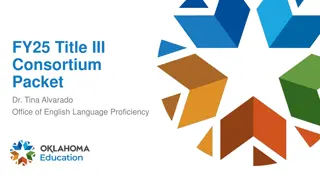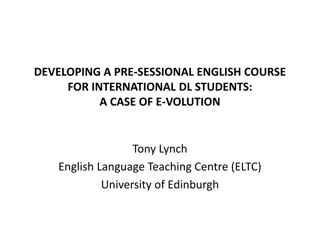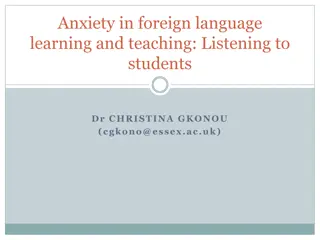English Language Teaching MODULE III
The different methods of language teaching, including Grammar Translation, Direct, Audio-Lingual, Audio-Visual, and Communicative approaches. Learn about their characteristics, advantages, and disadvantages.
Download Presentation

Please find below an Image/Link to download the presentation.
The content on the website is provided AS IS for your information and personal use only. It may not be sold, licensed, or shared on other websites without obtaining consent from the author.If you encounter any issues during the download, it is possible that the publisher has removed the file from their server.
You are allowed to download the files provided on this website for personal or commercial use, subject to the condition that they are used lawfully. All files are the property of their respective owners.
The content on the website is provided AS IS for your information and personal use only. It may not be sold, licensed, or shared on other websites without obtaining consent from the author.
E N D
Presentation Transcript
English Language Teaching MODULE III Haritha Unnithan, Dept of English
Methods of Language Teaching Grammar Translation method Direct method Audio-Lingual method Audio-Visual method Communicative Language Teaching CALL Structural method Functional- notional approach The Silent Way Suggestopedia, Community Language Learning.
Dominated in European and foreign language teaching from 1840s to 1940s Offspring of German scholarship Know everything about the subject rather than the subject itself. Primary focus is the understanding of literary text
Aims to study foreign language in order to benefit mental discipline and intellectual development. Approaches language first through the detailed analysis of its grammar rules to translate texts to and from the target language Language learning is all about memorizing rules and facts. First language as a reference system Major focus on reading and writing
Vocabulary enrichment- bi lingual dictionary and memorizing. Sentence as the basic unit- translation as the major process Accuracy emphasized- aim is to high standards in translation Grammar is taught deductively Native language is the medium of instruction Questioning and rejection of GT method during 1850s- a demand for proficiency in foreign languages- communication got importance. Led to the Reformist movement in 1880s.
Discipline of linguistics was revitalized Phonetics gave new insights to speech process International Phonetic Association in 1886 International Phonetic Alphabet(IPA) Reformist movement Study of the spoken language Importance to pronunciation Inductive method in learning Use of conversations and dialogues, phrases and idioms. Establish association with target language.
Direct Method An answer to the dissatisfaction with the older grammar translation method Has its origins in the Natural method which was popularised by Sauveur and Franke Intensive oral interaction in target language. Spontaneous use of foreign language in classroom Attention given to pronunciation Known words can be used to teach new vocabulary, using mime, demonstration and pictures.
Introduced in France and Germany Sauveur and Maximilian Berlitz in commercial schools Classroom instructions in target language Oral communication- question and answer exchanges Inductive learning of grammar Concrete vocabulary through demonstration and abstract through association of ideas Speech and listening comprehension Correctness of pronunciation and grammar.
Demerits Overemphasized the naturalistic learning Failed to consider practical realities Required teachers who were native speakers or who had native-like fluency Largely dependent on teacher s skill.
Proposed by American Linguists in 1950s (structural linguistics) o Foreign language learning is a process of mechanical habit formation. Language is a verbal behaviour. o The Audio-lingual Method was widely used in the 1950s and 1960s, and the emphasis was not on the understanding of words, but rather on the acquisition of structures and patterns in common everyday dialogue. o Memorizing dialogues and performing pattern drills. o Aural-oral training
set phrases are memorised with a focus on intonation Grammatical explanations are kept to a minimum Vocabulary is taught in context Audio-visual aids are used( tape recorders, language labs) Focus is on pronunciation Correct responses are positively reinforced immediately A teacher- dominated method. Active verbal interaction between teacher and learner.
Decline of Audio- Lingual Method With Noam Chomsky s theory against behaviourism Transformational generative grammar Languages are not acquired by repetition and imitation, but generated from learner s underlying competence .
Audio Visual method France 1950s foreign language is basically a mechanical process and it is more effective if spoken form precedes written form. The stress was on oral proficiency and carefully- structured drill sequences (mimicry/memorisation) and the idea that quality and permanence of learning are in direct proportion to amount of practice carried out.
The lesson begins with the filmstrips and tape-presentation. The materials are explained by the teacher through pointing, demonstrating, selective listening, question and answer. The dialogue is repeated several times and memorized by frequent replays of tape-recording and filmstrips or by language laboratory practice. Students are gradually emancipated by the filmstrip and tape-recorder. Advantages The students can easy understand the material because they are not only listening but also watching the presentation. The students will become fluent in speaking. Audio Visual Method enhances student learning and create a more inviting atmosphere.
The Disadvantages Basic method of teaching is repetition. Mechanical drills of early Audio-Visual approach is boring, mindless and counter productive. Audio-Visual materials were open to same sort of misuse. Audio Visual method doesn t develop writing and reading skill
CLT Maintained a functional approach to language teaching Theory Language is a system for the expression of meaning Primary fn. Of language is interaction or communication Structure of language reflects functional and communicative uses. Primary units- categories of functional and communicative meaning.
Functional communication activities and social interactional activities (Little wood) Negotiation of information or information sharing in target language. Teacher should facilitate the communication process. Games, role plays, task based communication activities.
Computer Assisted Language Learning Computer Assisted Language Learning ( CALL) ( CALL) "the search for and study of applications of the computer in language teaching and learning." ( Levy) CALL is the use of computer technologies that promote educational learning, including word processing, presentation packages, guided drill and practice, tutor, simulation, problem solving, games, multimedia CD-ROM, and internet applications such as e-mail, chat and the World Wide Web (WWW) for language learning purposes.
Structural Approach Arrangement of words is very crucial in English language Vocabulary is useless unless the reader is equipped with different patterns or modes in which words and phrases are used Stresses on sentence- structure one has to learn the structures Principles Speech is very important Learner-centered Fix up the habits of language patterns in English. Rely on- oral approach, drill method, situational approach
The Silent Way Devised by Caleb Gattegno Teacher should be silent as much as possible in the classroom Learner should be encourage to produce as much as language as possible. Language learning as problem solving creative, discovering activity Learner is the principal actor Takes a structural approach to the organization of language Students are presented with structural patterns of target language and grammar rules are learned inductively.
Learning is facilitated if the learner discovers or creates. The learner is not a bench bound listener but an active contributor to the learning process. Learning is facilitated by accompanying (mediating) physical objects. The Silent Way uses colorful charts and rods (cuisenaire rods) which are of varying length. They are used to introduce vocabulary ,colors, numbers, adjectives, verbs) and syntax (tense, comparatives, plurals, word order )
Learning is facilitated by problem solving involving the material to be learned. This can be summarized by Benjamin Franklin s words: Tell me and I forget Teach me and I remember Involve me and I learn A good silent way learner is a good problem solver. The teacher s role resides only in giving minimum repetitions and correction, remaining silent most of the times, leaving the learner struggling to solve problems about the language and get a grasp of its mechanism.
Community Language Learning (CLL) Charles A Curran Represents the use of counselling learning theory Humanistic approach Oral proficiency Give importance to learner s expressed communicative intentions and teacher s reformulations into suitable language utterances.
Activities Translation Group work Recording Transcription Analysis Reflection and observation Listening Free conversation Learning achieved collaboratively
Suggestopedia Developed by Bulgarian psychatrist- educator Georgi Lozanov The approach was based on the power of suggestion in learning, the notion being that positive suggestion would make the learner more receptive and, in turn, stimulate learning.
suggestopedia makes use of music, a comfortable and relaxing environment, and a relationship between the teacher and the student that is akin to the parent- child relationship. Music, in particular, is central to the approach. there is no apparent theory of language in suggestopedia and no obvious order in which items of language are presented. Aims to deliver advanced conversational proficiency quickly Not memorising but understanding and creative solutions to problems,
All participants sit in a circle Micro and macro studies Micro- grammar, vocabulary, qns. and answers Macro- role playing, innovative language conversations.
Notional Functional Approach The notional-functional approach is a way of structuring a syllabus around "notions," real-life situations in which people communicate, which are further broken down into "functions," specific aims of communication Functions often lend themselves naturally to specific grammatical patterns or common expressions For eg. How to buy from a shop?






